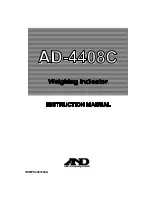
SECTION 5 CARE AND MAINTENANCE
5.1 THE METER CASE
Each opening of the case is gasketed to resist entry of water. When the case has been opened for any
reason, be sure that the main case gasket is accurately seated between both halves of the case, and that
the four case screws are drawn down securely (but not so tight as to deform the rubber feet).
5.2 PROBE PERFORMANCE CHECK
Every month when the probe is in daily use (less frequently otherwise), or whenever the probe
response is slow or calibration is unstable, check the probe performance.
1.
Speed of Response
¾
Prepare and calibrate the probe.
¾
With the probe in air, switch to the percent air saturation mode.
¾
Immerse the probe in a 25°C O
2
-depleted sample. (An O
2
depleted sample may be
prepared by adding approximately one gram of sodium sulfite to a half liter of water.)
¾
A properly functioning probe will respond down scale to 10% air saturation in 20
seconds or less.
2.
Background Current
¾
After performing the Speed of Response steps, leave the probe in the depleted sample for
approximately five minutes. The reading should fall below 1% air saturation.
3.
Calibration Stability
¾
Carefully calibrate the probe in moist air inside the calibration bottle with the instrument
set in the % air saturation mode.
¾
Allow the instrument to operate for one hour.
¾
A properly functioning probe will hold calibration 1% for one hour, after the
first hour of operation.
If the probe fails any of the three tests above, check for:
¾
Damaged or wrinkled membrane. Change the membrane and retest.
¾
Fouled or silver coated cathode. Clean as instructed in Section 3, Preparing the Probe.
¾
Fouled anode. Soak for 24 hours in 3% ammonia (NH3); rinse thoroughly with distilled water
and retest.
If these steps do not restore the probe to specification performance, return the probe to the factory for
service. See Section 8, for Warranty and Service Information.
5.3 PROBE
PRECAUTIONS
Membrane life depends on usage.
It is recommended that membrane caps not be re-used.
1.
To keep the electrolyte from drying out, store the probe in a moist environment, such as the
calibration chamber with the wet sponge inside.
2.
Erratic readings are a result of loose, wrinkled, damaged, or fouled membranes, or from large
(more than 1/4 of the circumference of the probe) bubbles in the electrolyte reservoir. If erratic
YSI Incorporated
YSI 58 DO Meter
17
Summary of Contents for 58
Page 1: ...YSI 58 Dissolved Oxygen Meter Operations Manual ...
Page 2: ......
















































